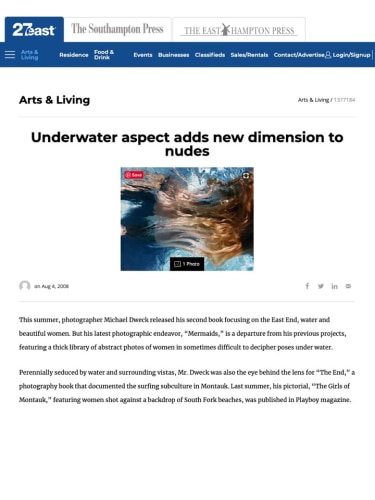Underwater aspect adds new dimension to nudes
East Hampton Press
08/04/2008
Back
This summer, photographer Michael Dweck released his second book focusing on the East End, water and beautiful women. But his latest photographic endeavor, “Mermaids,” is a departure from his previous projects, featuring a thick library of abstract photos of women in sometimes difficult to decipher poses under water.
Perennially seduced by water and surrounding vistas, Mr. Dweck was also the eye behind the lens for “The End,” a photography book that documented the surfing subculture in Montauk. Last summer, his pictorial, “The Girls of Montauk,” featuring women shot against a backdrop of South Fork beaches, was published in Playboy magazine.
But his most recent project, “Mermaids,” is his first undertaking actually shot underwater, or of women in the water from above the surface.
Similar to the inspiration for “The End,” the idea for “Mermaids” came from the Long Island native’s experiences fishing in the waters along the south shore and off Montauk.
During a recent phone interview from his Manhattan home, Mr. Dweck explained that on those long nights of fishing he had always been intrigued by the streaks of light that would flash through the water as fish swam by.
“The idea was, if I happen to fall overboard one night, what would I see down there? Those flashes of light could be mermaids,” he explained.
Once his imagination took flight, Mr. Dweck began shooting local women, such as Lauren Wingate, in pools in Amagansett and Montauk.
Most of the photographs in the book were shot during long nights submerged in water, when Mr. Dweck would often shoot from 9 p.m. to 2 a.m. in order to get the appropriate lighting and effects he was looking for.
“Everything is abstract, unlike the last book, which is a narrative about a place that was in my mind,” Mr. Dweck said.
The only narrative in this book can be found in the introductory essay written by Christopher Sweet. A former editor at Harry N. Abrams book publishers, Mr. Sweet eloquently captures the fantasy world of Mr. Dweck’s mermaids and outlines the process of capturing the images.
While working on the project, Mr. Dweck traveled back and forth to Paris and was influenced by the artwork he saw overseas, including works by Matisse and Irish-born figurative painter Francis Bacon.
“That’s why this work has no personality … It’s more about the form,” he said.
Mr. Dweck did not use professional underwater models, but women who were water lovers, including Ms. Wingate, an East End native who served as Mr. Dweck’s muse for the project and ended up being featured on the cover of the book.
“She loves the water. She’s really comfortable and she takes chances … She’s my honey in this project; I owe a lot to her,” he said.
Although some of the shooting took place locally, most of the photographs in the book were shot in the waters of the Weeki Wachee River in Florida, where Mr. Dweck traveled to find more subjects. There, he found a group of women, ranging in age from 20 to 38, from the rural island fishing village of Aripeka, Florida, who grew up on, and in, the water.
“They live on stilt houses, their fathers are stone crab fishermen and their parents teach them to swim from birth. The river becomes their playpen, basically,” he said, adding that these women could hold their breath for five to eight minutes at a time. “That’s their world, where they find happiness.”
Without a lot of opportunity in rural Florida for work, Mr. Dweck said the women held a range of jobs, from being performers in underwater shows to waitressing.
This fueled his idea that the water helps to isolate people, allowing them to shed psychic baggage and find refuge.
These, his true mermaids, are reflected in the photos as enigmatic and aloof beings. No facial features are identifiable and the women are mainly individualized by their long manes of hair suspended like tresses of seaweed.
“There’s a beauty to being under water that you can only see if someone is used to being in that environment,” Mr. Dweck said. “These girls actually transform. When they sink they just kind of transform into these beautiful creatures. It’s kind of like when you put a fish back in water.”
In order to capture this underwater world, Mr. Dweck would either dive down into the water with the women wearing an extra long snorkel, free dive, or shoot from behind a large glass wall that sectioned off a part of the river.
“I just started to experiment. I said to myself, ‘OK, I have light, I have a lens and I have water’” Mr. Dweck said, explaining how he came up with the abstract concept for the photos.
Photographs from “Mermaids” are currently on exhibit at the Staely Wise Gallery in Manhattan until September, when they will move on to galleries in Germany, Paris and Japan.
In order to expedite the process of having his books printed, Mr. Dweck and friends have also launched their own publishing company, Ditch Plains Press, which released an early run of “Mermaids” this summer.
The book is being sold at select locations, including East End Books, BookHampton, MOMA and the Parrish Art Museum in Southampton. The book costs $75, and 100 signed, limited editions with clamshell boxes and 8-by-10 chromogenic prints are being sold for $600 apiece. Mr. Dweck will be signing copies at the Vered Gallery in East Hampton on Friday from 6 to 8 p.m.
Mr. Dweck said he will continue to work with Harry N. Abrams, the publishing house that released “The End” in 2004.
The goal, he said, is to publish two books a year with Ditch Plains Press and one with Harry N. Abrams.
“I guess that means,” he said with a chuckle, “I have to take more photos.”